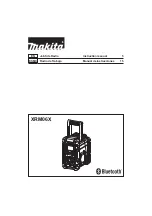
6. Install the radio back into the mounting bracket.
Connecting the Radio
To operate correctly, your radio requires two electrical connections:
• providing it with power from the boat’s electrical system
• connecting a VHF-FM marine antenna to the antenna connector
Power Supply Requirements
VHF Antenna Requirements
Nominal 13.8 VDC power supply with a negative ground (10.5 VDC to
16.0 VDC).
Power leads should be kept as short as possible. A direct connection
to the power supply is ideal.
Minimum of #14 AWG copper wire for extensions up to 20 feet, 12
AWG wire for extensions from 20 to 35 feet, or 10 AWG wire for
extensions from 35 to 60 feet.
Male PL-259 connector
50 Ω impedance
Minimum 3 foot, 3 dB rated antenna for sailboats or 8 foot, 6 dB rated
antenna for powerboats
Minimum RG-58 lead-in wire for antenna leads up to 20 feet, RG-8X
for antenna leads from 20 to 35 feet, or RG-8U for antenna leads from
35 to 60 feet.
1. Connect the BLACK wire of the power cable to the NEGATIVE (-) side of your power source.
2. Connect the RED wire of the power cable to the POSITIVE (+) side of your power source.
NOTE: To extend the life of the radio, use waterproof tape to seal electrical connections.
3. Install your antenna according to the manufacturer’s instructions.
4. If necessary, consult the FCC guidelines for antenna separation. See Antenna Selection and Installation on page 35 for more
details. (In summary, the FCC recommends that antennas up to 3 dB be installed a minimum of 3 feet from any occupied location;
antennas over 3 dB should be installed at least 6 feet away.)
5. Connect the PL-259 connector from the antenna lead-in wires to the SO238 connector labeled ANTENNA on the back of your radio.
6. Plug the power cable into the power cable pigtail on the back of your radio.
Connecting the Accessory Cable
Use the accessory cable to connect the radio to a GPS receiver, a GPS chartplotter, and an external speaker. The wiring diagram below
shows the connections for each accessory.
VHF595 RADIO
1-800-BOATING
23
















































